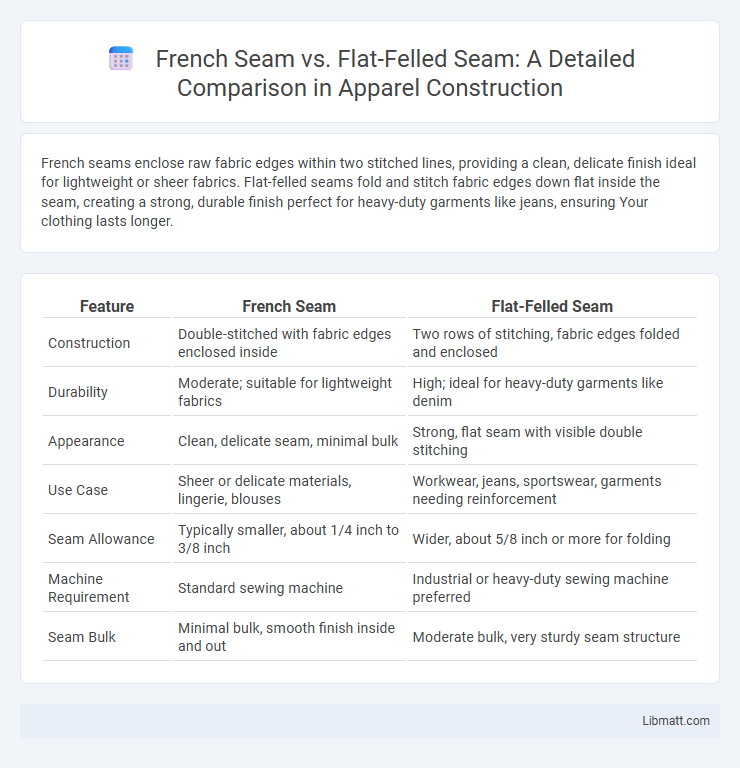French seams enclose raw fabric edges within two stitched lines, providing a clean, delicate finish ideal for lightweight or sheer fabrics. Flat-felled seams fold and stitch fabric edges down flat inside the seam, creating a strong, durable finish perfect for heavy-duty garments like jeans, ensuring Your clothing lasts longer.
Table of Comparison
| Feature | French Seam | Flat-Felled Seam |
|---|---|---|
| Construction | Double-stitched with fabric edges enclosed inside | Two rows of stitching, fabric edges folded and enclosed |
| Durability | Moderate; suitable for lightweight fabrics | High; ideal for heavy-duty garments like denim |
| Appearance | Clean, delicate seam, minimal bulk | Strong, flat seam with visible double stitching |
| Use Case | Sheer or delicate materials, lingerie, blouses | Workwear, jeans, sportswear, garments needing reinforcement |
| Seam Allowance | Typically smaller, about 1/4 inch to 3/8 inch | Wider, about 5/8 inch or more for folding |
| Machine Requirement | Standard sewing machine | Industrial or heavy-duty sewing machine preferred |
| Seam Bulk | Minimal bulk, smooth finish inside and out | Moderate bulk, very sturdy seam structure |
Introduction to Seam Finishes
French seam and flat-felled seam are two popular seam finishes known for durability and neat appearance. French seams encase raw edges within fabric layers, offering a clean finish ideal for lightweight or delicate fabrics, enhancing the longevity of your garment. Flat-felled seams, commonly used in jeans and workwear, involve folding and stitching the fabric edges flat for added strength and a professional look.
What is a French Seam?
A French seam is a sewing technique that encases raw fabric edges within a double-stitched seam, providing a clean, durable finish ideal for lightweight or sheer fabrics. Unlike flat-felled seams, which are commonly used for heavier materials and involve folding and stitching the seam allowances flat on the inside, French seams offer a delicate, precise look without bulk. Your garments benefit from increased neatness and strength with this method, especially in projects where seam visibility is a concern.
What is a Flat-Felled Seam?
A flat-felled seam is a durable, strongly reinforced seam commonly used in denim jeans and workwear, created by folding and stitching the fabric edges together to enclose raw edges completely. This seam enhances garment strength and prevents fraying, making it ideal for heavy-duty fabrics and high-stress areas. Compared to the French seam, the flat-felled seam is bulkier but offers superior durability and a clean finish on both sides.
Key Differences Between French and Flat-Felled Seams
French seams enclose raw fabric edges within two lines of stitching, creating a clean, delicate finish ideal for lightweight or sheer fabrics. Flat-felled seams fold and stitch fabric layers flat, offering exceptional durability and strength, making them suitable for heavy-duty garments like jeans and workwear. The main distinction lies in construction method and appearance: French seams provide a subtle, refined look while flat-felled seams emphasize robustness and flatness.
Strength and Durability Comparison
French seams provide moderate strength and are ideal for lightweight to medium-weight fabrics, offering a neat finish that encloses raw edges and reduces fraying. Flat-felled seams deliver superior strength and durability, commonly used in heavy-duty garments like denim jeans, as they involve double stitching and fully enclose raw edges to withstand stress and frequent washing. The reinforced structure of flat-felled seams makes them more resilient under tension compared to the more delicate, less bulky French seams.
Aesthetic Appearance: Which Looks Better?
French seams offer a delicate, refined finish with no visible raw edges, creating a clean and elegant aesthetic ideal for lightweight or sheer fabrics. Flat-felled seams display a more structured, durable look with visible topstitching that adds a decorative, tailored appearance often favored in denim and casual wear. The choice between the two depends on whether a seamless, polished look or a sturdy, detailed finish better suits the garment's style and purpose.
Best Uses for French Seams
French seams are best used for lightweight or delicate fabrics such as silk, chiffon, and organza, providing a clean and elegant finish while preventing fraying. Often favored in high-end garment construction and lingerie, they offer a discreet, reversible seam ideal for sheer materials. This technique enhances durability and adds a polished look without bulk, making it perfect for fine apparel and detailed sewing projects.
Ideal Applications for Flat-Felled Seams
Flat-felled seams are ideal for high-stress areas in garments like jeans, workwear, and sports uniforms due to their exceptional durability and clean finish. This type of seam prevents fraying by enclosing raw edges, making it perfect for heavy fabrics undergoing frequent washing and wear. When you need a strong and long-lasting seam that also offers a professional appearance, flat-felled seams are the optimal choice.
Step-by-Step Construction Methods
French seams start by sewing the fabric wrongly sides together with a narrow seam allowance, trimming edges, then pressing and folding the fabric right sides together to sew a second seam that fully encloses raw edges for a neat finish. Flat-felled seams require sewing fabric right sides together with a slightly wider seam allowance, trimming one seam allowance, folding the other over it, pressing flat, and topstitching to secure and create a strong, durable seam ideal for heavy fabrics. Your choice depends on fabric type and the desired seam strength or aesthetic, making these step-by-step methods essential for precise garment construction.
Choosing the Right Seam for Your Project
Selecting the perfect seam for your sewing project depends on fabric type and intended durability; French seams offer a clean, delicate finish ideal for lightweight or sheer fabrics, while flat-felled seams provide exceptional strength suited for heavy-duty materials like denim. French seams encase raw edges, preventing fraying, which enhances garment longevity and aesthetic appeal, whereas flat-felled seams fold and stitch fabric layers for robust reinforcement, commonly used in sportswear and workwear. Understanding these distinct construction techniques helps ensure your garment's quality and performance align precisely with your creative and functional needs.
French seam vs flat-felled seam Infographic

 libmatt.com
libmatt.com